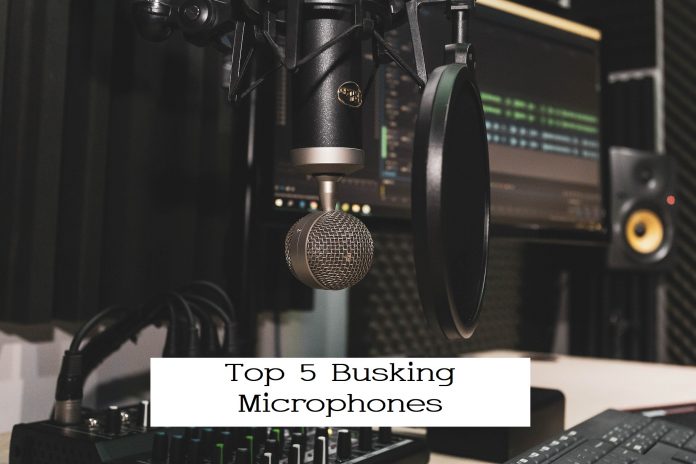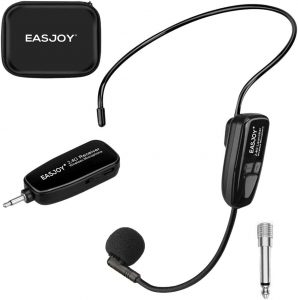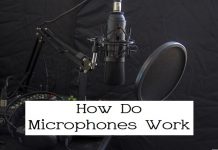When looking for the greatest busking microphone, one must keep in mind the success you would bring to the crowds on the sidewalk. Typically, I sing and play the guitar. My nephew is a keyboard player. I noticed that even buskers were playing drums! I’ve seen a lot of buskers use the standard boom microphone. The disadvantage of bringing more weight to your corner store with a boom stand-mounted, cheap singing microphone is that.
I would sing and play the guitar using a wired microphone and headphone (or any other stringed instrument, for that matter). Due to its great portability, this configuration would make it simpler for me to move around with my guitar and increase its affordability. When selecting a headset microphone for busking, there are a number of factors to take into account. A dynamic headset mic is attached but does not need to be set up wirelessly or with phantom power. Mobility may be hampered by unusualness, but it can also offer enormous flexibility.
Best busking microphone advice.
A fun and exciting way to gain experience or make some additional money is via busking. But it could also be daunting; if you’ve never done it before, it might be difficult to determine what you’ll need. In this article, I’ll go over a list of items you’ll need to get through your busking gig, but for the time being, have a look at the list.
Microphone.
If you can’t project your voice above the cacophony of a busy street or shopping mall, you’ll first need a microphone. This will help you be heard whether you sing softly and serenely or confidently and loudly. Choosing a dynamic microphone is advised because these are designed for live performances (compared to condenser microphones used for recording).
For busking, I’d advise the Shure SM58. This microphone is very reliable and conveniently cheaper than $100. It is the industry standard and has a lovely reputation, despite the fact that it isn’t the most modern type of microphone and I wouldn’t use it on a stage for a performance.
Microphone Add-Ons.
If you want to use your best busking microphone, you might need a few more. While others come highly recommended, some are essential. But if money is an issue, go with what you can manage.
XLR Cord.
An XLR cable is the key component you’ll need (like this one). This common microphone cable needs to be used to connect the microphone to the amplifier. Your microphone is essentially useless without this cable. I suggest using an XLR cable with a minimum length of 10 feet so you have some room to manoeuvre with the microphone. Otherwise, the leash connecting you to your amplifier will be very short.
Microphone Holder.
Despite not being required, a microphone stand is very useful. If you prefer to play with your hands or are using another instrument, a stand will free up both of your hands. It’s convenient in my opinion if you need to pause for a food or beverage. The microphone can avoid rolling about or getting scratched on the floor and suffering damage by being kept on the stand.
The microphone can pick up less background noise with the aid of a windscreen. The cardioid polar pattern of SM58 microphones means that less ambient noise will pass through the apparatus. However, when singing outside, wind might be a major problem. Imagine the wind noise from those ancient cassette recordings coming through your amplifier. If you place one of these windshields over your microphone, your voice will be plainly audible. However, it only works to muffle strong noises like pops and wind.
Live Music.
Live backing is preferred by the audience since it provides your show that extra something. The following is a list of the typical instruments used to accompany singers. acoustic guitar with a chord, pickup, and shoulder strap electric guitar (with cable and shoulder strap) Piano/keyboard (with stand, cable, and sustain pedal) Ukulele (with cable and pickup)
If you choose to take this route, you must be able to play the instrument well enough to focus more on your vocals. (Managing two tasks at once might be difficult!) You will also need the instrument itself as well as any related accessories (particularly to connect it to your amp).
Tracking Back.
When you employ a background track, all you are doing is singing along to a “karaoke” version of the song. Every song on your set list needs to be lyric-free and available digitally. Use KaraFun, an online karaoke service, or download these (for instance, through iTunes). Just make sure to download your music in advance so you can play them offline.
Naturally, in order to play the Music, you’ll also need a computer or music player, which you’ll attach to the amplifier using a link. You can use a CD player or an MP3 player to listen to music (such as an iPod)
Amplifier.
There are a few things to think about while choosing an amplifier, which I’ll list below. Overall, I think the Roland Cube Street EX is the best amp for buskers because it is designed with their needs in mind and has a large soundstage. For the same reason, the “Cube” series is among the most well-known on the streets.
If you like power, an affordable alternative is the less potent Boss II (the rebranded Cube Street II). The Roland Cube Street is available in this more modern incarnation for around half of the initial price.
Energy Source: Batteries
As a busker, you might not have access to PowerPoint. This suggests that a battery-powered feature is a requirement for all electronic devices. High-quality rechargeable batteries are often purchased by vocalists and musicians who utilise the Cube Street EX (8 AA batteries required) in order to stop buying fresh batteries all the time.
Fully charged batteries can run for 10 hours at half-power or 5 hours at their maximum power (50W) (25W). If you lower the wattage to 10W in a small arena, your batteries will last around 20 hours. With either of these options, you should have enough time to finish your performance, but having backup batteries never hurts.
Dynamic Headset Microphone, Shure WH20XLR.
The Shure WH20XLR is an affordable option for the best busking microphone with an adjustable headset. Shure has been the industry standard for professional audio microphones for more than 80 years. The microphone is secured with an elastic band to provide a snug fit. It also has a microphone boom that can be folded down for easy transportation and storage. Background noise is decreased by the microphone’s usage of a narrow cardioid pickup pattern. Additionally, it is designed to offer a normal and smooth frequency response for singing output, in contrast to other handheld microphones in its price range.
In order to complete the kit and increase its flexibility in hands-free outdoor conditions, Shure has included a belt clip and a windscreen. I believe that the Shure WH20XLR was developed for busking! I think that’s undoubtedly one of the best singing headphone microphones. Get a Shure RK318WS Black Foam Windscreens set as well, since the WH20XLR is missing a windscreen. A windscreen is necessary when busking in the open.
Audio-Technica PRO 8HEx Dynamic Headset Mic.
The wired dynamic headset microphone Audio-Technica PRO 8HEx’s polar hyper cardioid architecture enhances voice isolation while avoiding undesired feedback and background noise. A boom that spins and can be lowered from the right or bottom supports the microphone itself. Many reviewers have compared it to the Shure SM58, which I feel to be a big compliment. One analysis claims that the SM58 copies used in the club where he frequently performs are superior to the earlier ones.
If a headset mic can produce vocal reproduction that is comparable to an SM58 for around the same price as an SM58, utilising one while busking is worthwhile! Despite the fact that the AT PRO 8HEX lacks a windscreen, I advise purchasing one to reduce the pop and wind noises that would surely be present when busking outside. For such a windscreen, the Tetra-Teknica XFFZ5P-BLK is an excellent option.
Apex 370 Dynamic Headset Microphone.
The most affordable selection in the lineup is the Apex 370 dynamic headset microphone. A wired dynamic headset microphone with an XLR connector costs about $40. Buskers on a tight budget may also use this as an alternative, or someone trying it out before deciding to invest more than $75 on a nicer headset. It is a dynamic microphone, the Apex 370. As a result, phantom control is not necessary, but as some critics have noted, the microphone’s performance may be on the lower end of the performance spectrum. The microphone does not compress for storage, but it does have a flexible gooseneck and an adjustable headband.
This busking kit comes with a 15-foot cable, a headset microphone, and a foam windscreen that is ready to use right out of the box! The Apex 370 can handle high SPL rates and a unidirectional polar pattern to reduce feedback. Although it is reasonable to anticipate that the microphone will fall toward the lower end of the price spectrum, a different inspection revealed that the fit and finish are weak.
Headset with wireless microphone.
Look no farther than this EasJoy 2.4 GHz Wireless Microphone Headset for the perfect portable microphone for street performers. It works with any amplifier or PA and is inexpensive and simple to use. Sure, it doesn’t look as rock and roll as a big microphone on a stand, but when it comes to convenience, why would you want to carry around the extra equipment?
The best microphone depends largely on how you set up and perform. Do you plan to play an instrument in addition to singing? Do you choose a wired headpiece over a conventional microphone on a stand? Keep these points in mind when selecting the best microphone for busking. Will a less costly microphone produce vocals that sound just as good as a more expensive one? Naturally not, but because everyone has to start somewhere, I’ve put together a list of some of the best mics for buskers of all ability levels.
Conclusion.
I chose the Audio-Technica PRO 8HEx after carefully examining the headsets available above the finest busking microphone. It is a headset with a dynamic microphone. Phantom power is hence not required. A hypercardioid microphone is also included for better clarity and reduced background noise. The majority of reviews for this top busking microphone were favourable, and the Shure SM58 was frequently mentioned. The AT Pro 8HEx, in my opinion, is the best busking microphone currently on the market.

















